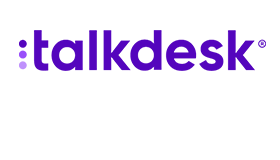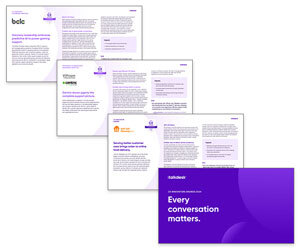Celia Cerdeira at Talkdesk breaks down the key differences between call centres and contact centres and explain why the latter is transforming customer experience.
Discover the key differences between call centres and contact centres – and why the shift to AI-powered, omnichannel support is redefining customer experience.
Every excellent customer relationship starts with a conversation – but in today’s world, customers expect more than just a phone call. They want fast answers, personalized service, and the freedom to connect on their terms.
Call centres were the go-to for customer support for decades, but their phone-only approach and long wait times often led to frustration. Today, organizations must adapt to changing customer expectations or risk losing them to competitors.
Contact centres expand the possibilities by offering multiple communication channels and AI-powered automation. Contact centres can provide a smoother, more personalized customer experience, support agent workflows, and give organizations a competitive advantage.
What Is a Call Centre?
A call centre is a dedicated office where teams of agents handle inbound and outbound customer calls. These teams typically assist with orders, returns, service requests, and troubleshooting, serving as a company’s frontline for customer interactions.
The first modern call centre emerged in the late 1960s in the United Kingdom. By the 1970s, call centres became mainstream with the introduction of Rockwell International’s Galaxy Automatic Call Distributor, a telephone booking system that streamlined call handling.
Around the same time, telephone headsets gained popularity, inspired by those used in NASA’s Mission Control Center during the Apollo missions. Headsets made it easier for agents to manage high call volumes efficiently.
The introduction of toll-free “800 numbers” revolutionized customer service by allowing customers to call businesses at no cost, shifting the expense from consumers to companies.
During the 1970s and 1980s, technological advancements revolutionized call centres. Key innovations included:
- Speech recognition, paving the way for interactive voice response (IVR) systems.
- Text mining to analyze customer interactions.
- Universal and virtual queues for smarter call distribution.
- Automatic call distribution (ACD) to route calls efficiently.
- Skills-based routing to match customers with the most qualified agents.
These advancements laid the groundwork for the next evolution of customer service: the contact centre.
What Is a Contact Centre?
While both call centre and contact centre agents troubleshoot customer issues, a contact centre leverages advanced technologies and multiple communication channels to offer a better customer experience, while making agents’ jobs easier.
Connecting With Customers on Their Terms
A traditional call centre relies exclusively on voice communication, offering just one channel for customer interactions. In contrast, a contact centre provides an omnichannel experience, allowing customers to connect through multiple platforms for a frictionless experience.
Those multiple communication channels might include:
- Phone: Traditional voice support.
- Email: Ideal for less urgent inquiries.
- Social media: Support via platforms like X (Twitter), Facebook, or Instagram.
- SMS messaging: Quick, on-the-go assistance for mobile users.
- Live chat & AI chatbots: Instant online support via human agents or AI.
- Video calls: Personalized support for complex or high-value interactions.
A customer might start a conversation over the phone, follow up via email, and continue through live chat – without repeating their issue or losing context.
This flexibility ensures that every customer can engage in the way that suits them best, whether that’s texting for quick support, emailing for a detailed inquiry, or calling for a personal touch.
Unlike a call centre, which may be limited by business hours and agent availability, a contact centre can offer 24/7 assistance.
AI-powered chatbots can handle common inquiries instantly, reducing wait times and improving response efficiency. As a result, organizations can deliver faster resolutions and higher customer satisfaction.
Leveraging Data for More Efficient Customer Service
Call centres can collect basic customer data, such as previous call logs and agent notes, which provide some insight into past interactions.
However, this data is often limited in scope and may not give agents the complete picture of a customer’s history or needs.
In contrast, contact centres leverage advanced software and customer relationship management (CRM) integrations to compile a rich, detailed dataset that enhances customer interactions.
Contact centres provide access to crucial contextual information, such as:
- Previous interactions: Ensures seamless conversations across phone, email, chat, and other channels without requiring the customer to repeat questions.
- Purchase history: Enables personalized recommendations and proactive assistance.
- Customer lifetime value (CLV): Helps prioritize and tailor service for high-value customers.
By unifying data across multiple channels, contact centres provide agents with a complete view of the customer relationship, enabling faster issue resolution, personalized recommendations, and even proactive support before a problem arises.
Optimizing Workflows Through the Power of AI
Contact centres don’t just facilitate conversations – they optimize them. By combining AI-driven intelligence with human expertise, contact centres can transform customer service from a reactive support function into a proactive strategic advantage.
AI-powered analysis of customer interactions can help agents anticipate needs and improve performance. On the front end, AI-powered features can streamline customer inquiries and enhance their overall experience.
Some of the most impactful AI capabilities include:
- Intelligent call routing: Directs inquiries to the right agent or self-service option for faster resolution.
- Customer sentiment analysis: Helps agents gauge customer emotions in real time, allowing for more empathetic responses.
- Advanced analytics: Identifies customer pain points and tracks agent performance to drive continuous improvement.
By leveraging omnichannel communication, data integration, and AI-driven insights, contact centres deliver a more seamless, efficient, and personalized customer experience – setting a new standard for customer service.
What Are the Different Types of Contact Centres and Call Centres?
Call and contact centres serve the same fundamental purpose – connecting businesses with their customers, whether for inbound or outbound communications.
Call centres and contact centres are often remote or virtual, and both increasingly leverage AI tools to optimise operations.
The difference is that contact centres, in all of these cases, expand on traditional call centre functions in ways that improve agent workflows and customer satisfaction.
Inbound Contact Centres vs. Inbound Call Centres
Inbound centres are where customers turn when they have an issue. Customers might reach out for service inquiries such as order or billing questions, technical support, or other troubleshooting.
Inbound call centres allow customers to call in with questions and talk with an agent directly.
Inbound contact centres take a more flexible approach, allowing customers to contact them through the channel of their choice, whether calls, texts, emails, chats, or other means.
Outbound Contact Centres vs. Outbound Call Centres
Outbound centres empower agents to reach out proactively, whether to contact potential customers, collect feedback, follow up with current customers, or share special offers.
Outbound call centre agents focus on calling customers, a standard method in telemarketing and upselling efforts.
Outbound contact centre agents might use various channels to contact customers. Contact centre software can integrate with CRM systems to automatically update contact lists.
Virtual Contact Centres vs. Virtual Call Centres
The need for remote flexibility has led to the rise of virtual customer service teams. The virtual or cloud model avoids the need for costly on-premises infrastructure and makes it easier to scale capabilities as needed.
Virtual call centres consist of remote agents who handle inbound or outbound calls.
Virtual contact centres operate entirely on cloud-based platforms, meaning agents can work from anywhere using a computer and an internet connection.
AI-Powered Contact Centres vs. AI-Powered Call Centres
Artificial intelligence is transforming customer service by streamlining interactions and enhancing efficiency.
- AI call centres support agents through automatic call routing. AI can’t replace live call centre agents but can enhance customer service.
- AI contact centres leverage advanced AI tools, including chatbots, virtual assistants, and predictive analytics. These features deliver more personalized, convenient support to customers while streamlining workflows for agents.
Overall, while both call centres and contact centres serve as customer communication hubs, contact centres offer greater flexibility, efficiency, and personalisation.
Top KPIs for Call Centres vs. Contact Centres
Call centres and contact centres share many of the same key performance indicators (KPIs), especially those focused on efficiency and customer satisfaction. However, their focus differs:
- Call centres primarily handle voice interactions, meaning KPIs tend to revolve around call-handling efficiency, agent performance, and resolution speed.
- Contact centres must also measure omnichannel engagement and customer experience across different touchpoints.
While both call and contact centres focus on delivering high-quality customer support, tracking the most relevant KPIs helps an organization optimize its operations, improving both customer experience and agent productivity.
KPIs Common to Both Call Centres and Contact Centres
- First call resolution (FCR): Measures how often a customer issue is resolved in the first interaction.
- Average handle time (AHT): Tracks how long an agent spends resolving a customer inquiry.
- Customer satisfaction (CSAT) score: Evaluates customer sentiment post-interaction.
- Service level: Measures how quickly customer inquiries are addressed within a given time frame.
- Agent turnover rate: Tracks how frequently agents leave a company.
- Call abandonment rate: The percentage of customers who hang up before reaching an agent.
- Average wait time: How long customers wait in the call queue before speaking to an agent.
- Occupancy rate: The percentage of time agents spend actively handling calls versus idle time.
KPIs More Relevant to Contact Centres
These metrics are beneficial for contact centres seeking to measure efficiency and customer satisfaction.
- Customer effort score (CES): Measures how easily customers can resolve issues across multiple channels. With a contact centre, customers often use self-service, chat, email, or social media before escalating to a live agent.
- Self-service containment rate: Measures the percentage of inquiries resolved without human agent intervention (e.g., through AI chatbots or knowledge bases). Since contact centres often provide self-service options across channels, this KPI is key to assessing automation effectiveness.
Tracking the right KPIs – whether for a call centre or a contact centre – ensures organizations can optimize performance, enhance customer satisfaction, and make data-driven decisions that drive long-term success.
Which Customer Experience Solution Is Right For My Organization?
Deciding between a call centre and a contact centre depends on a company’s needs, customer preferences, and business goals.
For businesses that communicate with customers mainly over the phone, a call centre may be the best fit.
However, for companies that value flexibility, personalization, and multichannel engagement, a contact centre offers a more dynamic approach.
Customers today expect interactions across channels, and meeting these expectations is in any organization’s best interest.
Consider the following factors:
- Operational scale: Organizations with smaller customer bases may prefer the simplicity of a call centre, while those managing high-volume, multichannel interactions benefit from a contact centre’s efficiency.
- Personalization: If tailored customer experiences at scale—such as AI-driven recommendations—are a priority, a contact centre is the better choice.
- CRM integration: A contact centre integrates more fully with CRM systems, giving agents access to customer history, preferences, and past interactions.
- Data analysis: Contact centres provide deeper data insights that can help an organization improve agent efficiency and customer satisfaction.
Choosing between a call centre and a contact centre comes down to your business needs, customer expectations, and long-term goals – ensuring the right fit can drive efficiency, satisfaction, and competitive advantage.
This blog post has been re-published by kind permission of Talkdesk – View the Original Article
For more information about Talkdesk - visit the Talkdesk Website
Call Centre Helper is not responsible for the content of these guest blog posts. The opinions expressed in this article are those of the author, and do not necessarily reflect those of Call Centre Helper.
Author: Talkdesk
Reviewed by: Jo Robinson
Published On: 17th Apr 2025
Read more about - Guest Blogs, Celia Cerdeira, Talkdesk






 Talkdesk is a global customer experience leader for customer-obsessed companies. Our contact center solution provides a better way for businesses and customers to engage with one another.
Talkdesk is a global customer experience leader for customer-obsessed companies. Our contact center solution provides a better way for businesses and customers to engage with one another. 












